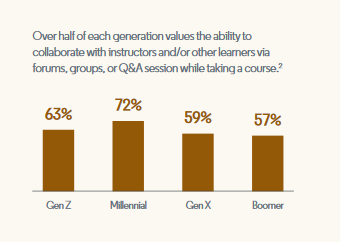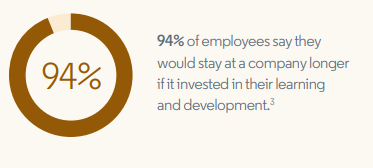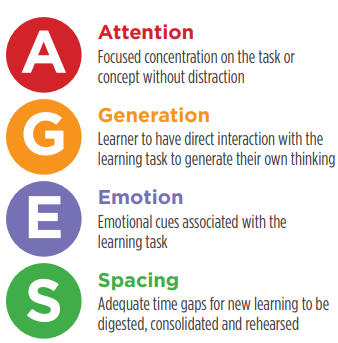In 2019, if there was one keyword to define workplace learning and training it was “LXP” or the Learning Experience Platform. We saw several new products in the market and several companies decided to add features to their existing LMS and re-market the product as an LXP. In 2020, we expect the buzz around LXPs to continue and gather momentum. In our latest blog post, we look at what we believe could be some of the high-impact eLearning trends in workplace learning and L&D this year.

Table of Contents
Learning as a Service or LaaS
In our blog post titled ‘Key eLearning Trends for 2019’; the first trend that we had listed was the steady transition from SaaS to LaaS as more organizations looked to explore the concept of learning as a service. In 2020, this will continue to grow as per industry predictions. Professor Mohanbir Sawhney from the Kellogg School of Management writes in this Forbes article on the impact of LaaS in lifelong learning and the software and services industry. LaaS is favored by organizations which are looking to cut down on the cost of developing and deploying a full-fledged learning program. Instead of paying a large one-time fee and getting a learning program that cannot be updated; organizations prefer to opt for LaaS and ‘rent’ or ‘subscribe’ to learning services that can be updated when required. In this blog post on the TSIA blog, Maria Manning-Chapman shares some valuable insights on why LaaS is becoming popular and how it benefits organizations. This could very well be the year when LaaS goes mainstream.
Social Workplace Learning
The LinkedIn Workplace Learning Survey Report 2019 offers a lot of insights into how workplace learning is transforming. This survey pools together responses from relevant L&D professionals from around the world and offers a report on the trends in workplace learning. Organizations around the world have welcomed ‘Generation Z’ workers into their organization. Training them is a different challenge altogether. Some stats from the report:


Social and Mobile Learning shall continue to feature in lists like this for some time till something else arrives that moves our attention lock, stock, and barrel to it; and that’s not something that we foresee in the immediate future. Organizations which build newer learning platforms or eLearning service providers who develop eLearning programs will continue to add a ‘social element’ to their solutions.
Boosting Employee Motivation with Learning
An interesting stat from the LinkedIn Report is listed below:

It is no surprise that employees prefer to stick to an organization that offers a great learning culture and an environment for sustained growth. In an interesting article from McKinsey members of the Consortium for Advancing Adult Learning & Development (CAALD) make some interesting observations on leadership and learning culture. Lynda Gratton, professor of management practice at the London Business School makes an interesting statement which we quote below:
“The leaders I see who are really building an organization that’s adaptable, that’s going to be able to upskill and reskill their employees over time, are those who not only are honest about their own failings but also create an environment of psychological safety for their employees so that they are comfortable making mistakes as they learn.”
Read the complete article for different perspectives on leadership and learning.
An organization that values its employees and fosters learning with engaging and effective training programs will have happy employees. Employees who are happy will work with renewed vigor and confidence. This will contribute to organizational growth and better business results.
Curated eLearning Content
The 2019 Workplace Learning Report from LinkedIn also cites curated learning paths as an ideal way to scale L&D and meet training requirements. Two interesting stats from the report:

In addition to the actual course content, learning programs could integrate links to relevant videos on YouTube, or presentations on SlideShare that could help the learner understand the topic better. The curated eLearning content need not just be restricted to free resources. Organizations when creating eLearning content to train their employees could also link to paid training content from course aggregators like Coursera or Udemy to offer a great learning experience. The future of workplace learning is striking the right balance of customized eLearning content and off-the-shelf training content that can add value.
Using Neuroscience and Cognitive Learning Theory
Cognitive Learning Theory has been used extensively in schools and universities to prepare better academic programs for students. In the last decade, significant research has been conducted in neuroscience to establish how the human brain processes learning. Adults learn by building on existing neural maps or networks. Research in neuroscience shows us a path or framework to improve learning in adults. Lila Davachi from New York University lists this framework called “AGES” which helps make learning effective and engaging.

This graphic was sourced from this excellently written whitepaper published by PageUp People.
In 2020, L&D specialists will work closely with learning psychologists and neuroscientists to devise solutions that make learning easier and more effective. We recently conducted a webinar featuring Clark Quinn Ph.D. and Swapna Reddy on Cognitive Science and Organizational Performance. You can view the recording of the webinar here [MR1] for more insights on the topic. Also, note that the research findings of neuroscientists are used to make AI better and more efficient. This article by Ryan F. Mandelbaum published on Gizmodo offers some fascinating insights into how neuroscience is shaping the AI of tomorrow.
Voice-Powered Learning
Some interesting stats from Gartner:
- By 2023 a quarter of worker interactions with software will be mediated by voice.
- This is up from less than 3% in 2019.
- 25% of employees who do digital work will use a virtual assistant on a daily basis by 2021.
The incredible success of Alexa and Siri has made voice-powered bots an attractive business proposition. The use of voice-powered bots and search and reply functions have increased across industries. Be it a bank’s website, or an insurance-provider, or an ad-agency, or a food-delivery service, the voice-bot is the first level of interaction that a customer gets. In most cases, the customer is guided by the bot and finds answers. Only when the bot’s efforts fail does human intervention arrive. This helps companies save a lot of costs in terms of manpower and salaries. This illustration shows the key stages in a natural language processing system. Chinese tech-giant Baidu is giving Google stiff competition in innovation and machine learning.

L&D teams are also using voice-powered bots in eLearning solutions. Be it as a course-discovery aid to find and learn programs on new topics or as a task reminder within the program, the possibilities and opportunities in voice-powered learning are huge. Origin has integrated voice-powered search in Fractal its flagship learning experience platform, which you may wish to explore. We believe 2020 would be the year when voice has a significant impact on workplace learning and more organizations start deploying voice-powered bots in their learning solutions. The increasing use of voice-powered search in eLearning systems is an eLearning trend that is likely to find more favor in the next few years.
Intelligent Use of Data and Machine Learning
We have written in detail about the value of data analytics and its impact on workplace learning. Data is being primarily used to measure the progress of the learner in a program and the learner’s likes/dislikes which are then used to recommend relevant learning programs. But what else can we use data for? IBM Watson is a shining example of putting data and machine learning to good use. HR teams can use IBM Watson for a wide variety of activities. From recruitment to coaching, identifying skills, recommending ideal skill development programs, and answering questions about roles, responsibilities, and benefits, IBM Watson is the real deal.
This video from the good folks at CrashCourse offers a good introduction to Machine Learning and Artificial Intelligence. What was conceived as science fiction and speculative fiction 50 years ago is slowly turning into reality. We have powerful smartphones that function as microcomputers, we have assisted driving in vehicles, drones delivering medicines in remote areas, robots enabling production in factories, technology has truly transformed lives. In 2020, we believe that data will have an important role to play in the way eLearning is created and deployed. Let’s revisit this topic next year to examine how it pans out. Among the various eLearning trends for 2020, we are quite excited about the use of intelligent data, machine learning, and artificial intelligence.
eLearning Bundled into a USB-Drive a Cost-Effective eLearning Trend
This strategy has been adopted to a great degree of success by companies focusing on the K12 education sector and institutes preparing students for exams like the GMAT, GRE, TOEFL, SAT, etc.
Modern workplace learning is heavily dependent on the learner finding time to learn outside of the actual work hours. This might not work well for everyone. Learners look for options to learn at their
own convenience. This necessitates deploying learning on a mobile app that the learner can access when they find free time while commuting or when at leisure at home. Alternatively, they could be
given access to an LMS that does not have firewall or network restrictions. Either of these options would incur a significant cost and would always require the learner to have strong internet connectivity, irrespective of their location. Not everyone would have the luxury of high-speed internet, especially while traveling or if living in a rural area.
So how do organizations tackle this challenge? This where the humble USB-drive can become a savior. See this innovative project from Torrance Learning where they bundled the eLearning content into a
USB-drive. “The USB drive contains a Chromium web browser and web server, allowing the elearning course to play from the USB no matter what computer it’s plugged into”.
As organizations look to deliver high-quality eLearning with ease – it is quite surprising that the practice of bundling corporate eLearning into a USB-drive has not yet become mainstream. Perhaps 2020 could be the year when organizations wake up to this possibility.
Enhanced Learning with Cutting-Edge LXPs – the eLearning Trend that’s a Buzz Word
The LXP, the LMS, the LCMS, the mobile learning app – all of these are mediums to deliver eLearning and in 2020 there will be a space for each of these platforms. A single organization could use two or more of these learning delivery platforms to meet their internal and external learning requirements. Nothing is going to turn obsolete as each platform has its own niche benefits and serves a specific requirement. Or an organization could be tied to a specific product as a long-term contract or be limited by budget constraints for not migrating to a newer learning delivery system. In any case, the LXP market continues to grow at breakneck speed. On our Origin Fractal blog, we have published a detailed post on five key trends to watch out in LXPs for 2020. These are:
- Learning in the flow of work
- Increased awareness in different industries about the use and benefits of LXPs
- Learning curation features in LXPs
- Recommendation Engines
- In-built course-authoring tool
There are some trends and factors that make to these lists on a regular basis. These are gamification, mobile learning, cloud-based learning, personalized, and adaptive learning. The L&D space is huge, the industry is in a constant state of innovation, but there are also organizations content and rock steady in doing just a few things and sticking to their strengths. Reports published by industry monitoring agencies show staggering numbers in terms of growth, business opportunities, and technology innovations. Amidst all the noise and buzz about technology and disruptive design and learning experiences, we should remember as L&D professionals that learning should be simple and engaging. Quite often in the pursuit of glory, we complicate things. This year, let’s step back for a while and think about making workplace learning truly meaningful and engaging. Do share your picks for trends in eLearning for 2020.
Additional Reading:
